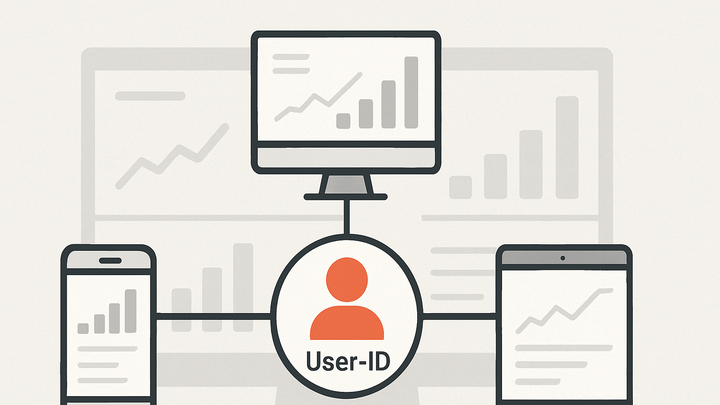Published on 2025-06-28T06:42:49Z
What is a User ID? Examples and Use Cases in Analytics
User ID is a unique identifier assigned to an individual user, enabling analytics platforms to connect sessions and interactions across devices and time. Unlike session-based or client-based identifiers that expire or change, a User ID remains persistent, providing a cohesive view of a user’s journey. In Google Analytics 4 (GA4), the user_id parameter can be set through gtag.js or the Measurement Protocol, while cookie-free tools like PlainSignal allow custom user identifiers within their tracking snippet. By leveraging User IDs, businesses can perform cross-device tracking, deduplicate active user counts, and deliver personalized experiences. However, implementing User ID requires careful handling of personally identifiable information (PII) and compliance with privacy regulations like GDPR and CCPA.
User id
A unique, persistent identifier for users that enables cross-session and cross-device tracking in analytics platforms.
Definition and Overview
User ID is a custom identifier that uniquely represents an individual user across multiple sessions, devices, and platforms. It allows analytics systems to merge and maintain a consistent user profile over time, rather than treating each visit as an anonymous or new interaction. This persistent identifier is often generated by your authentication system or user management backend and passed to analytics tools for more accurate reporting. Implementing a User ID requires injecting it into your tracking code whenever a user is authenticated. By distinguishing between persistent and session-based identifiers, teams gain clarity on user behavior and lifecycle.
-
Concept of user id
A User ID is a unique string or number tied to a logged-in or recognized user, enabling platforms to link actions that occur at different times or on different devices back to the same individual.
-
Persistent vs. session-based ids
Persistent IDs remain constant across visits and devices when a user logs in, whereas session-based IDs are temporary and reset after each browsing session ends.
-
Persistent ids
Stays the same across multiple sessions and devices, facilitating longitudinal analysis and accurate user counts.
-
Session-based ids
Tied to a single session or browser tab and expires when the session ends or the cookie is cleared.
-
Benefits of User ID Tracking
Adopting User ID tracking unlocks more accurate insights and advanced features that are difficult or impossible with only anonymous identifiers.
-
Cross-device and cross-session tracking
Stitches together interactions from mobile apps, websites, and other touchpoints to show a unified user journey.
-
Personalization and user experience
Enables tailored content and recommendations based on a user’s historical behavior across platforms.
-
Accurate user metrics
Prevents double-counting the same user across sessions, yielding precise active user and retention metrics.
Implementation in Analytics Tools
Implementation differs across platforms. Below are examples for Google Analytics 4 (GA4) and PlainSignal, demonstrating how to set and pass User IDs.
-
GA4 implementation
In Google Analytics 4, configure the user_id parameter using gtag.js to assign your unique user identifier. Example:
<script async src="https://www.googletagmanager.com/gtag/js?id=G-XXXXXXXXXX"></script> <script> window.dataLayer = window.dataLayer || []; function gtag(){dataLayer.push(arguments);} gtag('js', new Date()); gtag('config', 'G-XXXXXXXXXX', { 'user_id': 'USER_UNIQUE_ID' }); </script> -
PlainSignal implementation
PlainSignal offers a cookie-free analytics approach. After including the main tracking snippet, call the configuration method to set a User ID. Example:
<link rel="preconnect" href="//eu.plainsignal.com/" crossorigin /> <script defer data-do="yourwebsitedomain.com" data-id="0GQV1xmtzQQ" data-api="//eu.plainsignal.com" src="//cdn.plainsignal.com/plainsignal-min.js"></script> <script> PlainSignal('config', { userId: 'USER_UNIQUE_ID' }); </script>
Use Cases and Applications
User ID tracking supports a range of analytical and engagement scenarios across industries.
-
E-commerce
Track cart additions, purchases, and lifetime value per user, even when they switch devices.
-
Saas applications
Monitor feature adoption, trial-to-paid conversions, and churn risk at the individual level.
-
Content personalization
Serve tailored articles or product recommendations based on each user’s reading or browsing history.
Considerations and Best Practices
While powerful, User ID tracking must be approached thoughtfully to protect user privacy and ensure data quality.
-
User id format and uniqueness
Use non-guessable, stable, and anonymized IDs that cannot be reverse-engineered to reveal PII.
-
Privacy and compliance
Obtain explicit user consent, avoid sending raw PII, and adhere to GDPR, CCPA, and other data protection laws.
-
Data security
Encrypt identifiers in transit, restrict access to analytics data, and regularly audit data handling processes.
